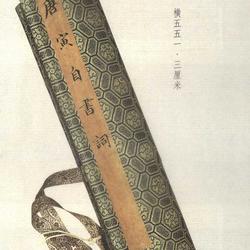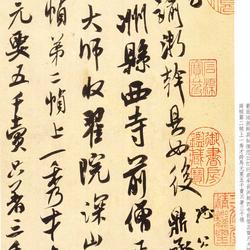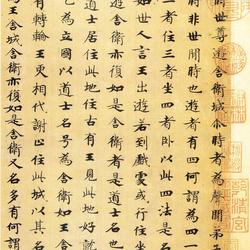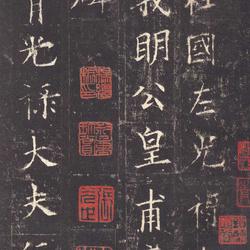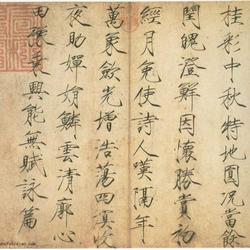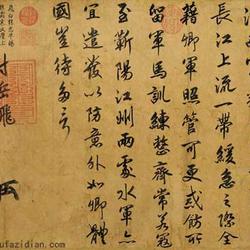Li Bai (701-762), also known as Taibai, also known as Qinglian Jushi. His ancestral home was Chengji, Longxi (now Qin'andong, Gansu Province). At the end of the Sui Dynasty, his ancestors lived in Suiye (now the Chu River Basin south of Balkhash Lake).A great poet of the Tang Dynasty, he was worshiped by the Imperial Academy when he was an official.
Li Baixian's cursive calligraphy master Zhang Xu, however, the title of the book is hidden by the title of the poem. According to the "Xuanhe Shupu" of the Song Dynasty, Li Bai's writings collected by the Song Dynasty include two kinds of running scripts: "Taihua Peak" and "Chengxing Tie", cursive scripts "Sui Wen", "Poems about Wine", "Drunken Poems" "Zhongtie" three kinds. Of course, there are also those that are spread among the people and are hidden at the bottom of the box because they are "valued as precious treasures", because many of Li Bai's poems were originally written for ordinary people, which was part of his warm hospitality for them. reward. However, with the passage of time, the oral dissemination and publication of Li Bai's poems have been passed down from generation to generation, but his ink marks have continued to disappear and disappear. There are also descriptions in the history books of the past dynasties. "Li Bai's Tombstone" says: "Hanlin's calligraphy is high and elegant." "Xuanhe Shupu" records: "Bai Chang wrote running script, and his calligraphy and painting are especially elegant." Song Huangshangu once commented: "Li Bai was in Kaiyuan, Tianbao, etc. It can be passed down through writing. Today’s practice is no worse than that of the ancients.” (Volume 26 of "Gu Nei Ji" "Inscribed on Li Bai's Poems"). Zhou Xinglian of the Qing Dynasty also said in "Linchi Guanjian" that Taibai's calligraphy is "fresh and lively, with a pure breath, free from the mundane world, and floating with a fairy spirit." It can be seen that as the most outstanding romantic poet in the Tang Dynasty, he also expressed his calligraphy in his calligraphy works. Full of romantic and freehand sentiment.
Today, the only piece of ink we can see that is attributed to Li Bai is "Tie to the Upper Balcony". Looking at the appearance of this post, it is vigorous and elegant. The writing is vertical and horizontal, and the stroke is released at the end of the pen. The pen is used freely and freely, fast and smooth, just like Li Bai's bold and elegant poetic style, which is consistent with the comments of the ancients. , the poem is like the person, and the book is like the person.
The ancient masterpiece "Shiqu Baoji·First Chapter", which is the most complete collection of calligraphy and painting records in my country, contains: Li Taibai of Tang Dynasty's "Tie on the Balcony". The height of the post is: eight inches and eight points (712.5px), and one inch and nine points (952.5px). A total of five lines and twenty-five characters, now in the collection of the Palace Museum in Beijing.

Li Taibai's "Tie to the Balcony" on paper, 28.5cm in length and 38.1cm in width. There are 5 lines of cursive script, a total of 25 words.
Explanation: "The mountains are high and the water is long, and there are millions of objects. It is impossible to be poor without an old pen. On the 18th, I went to the balcony to write, Taibai."
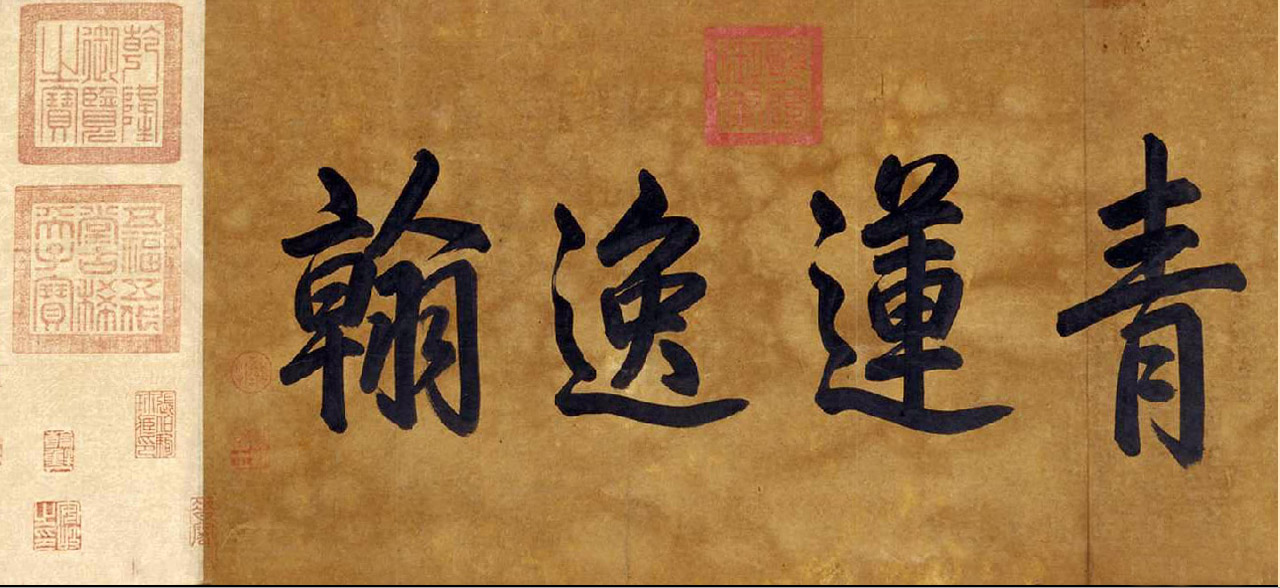
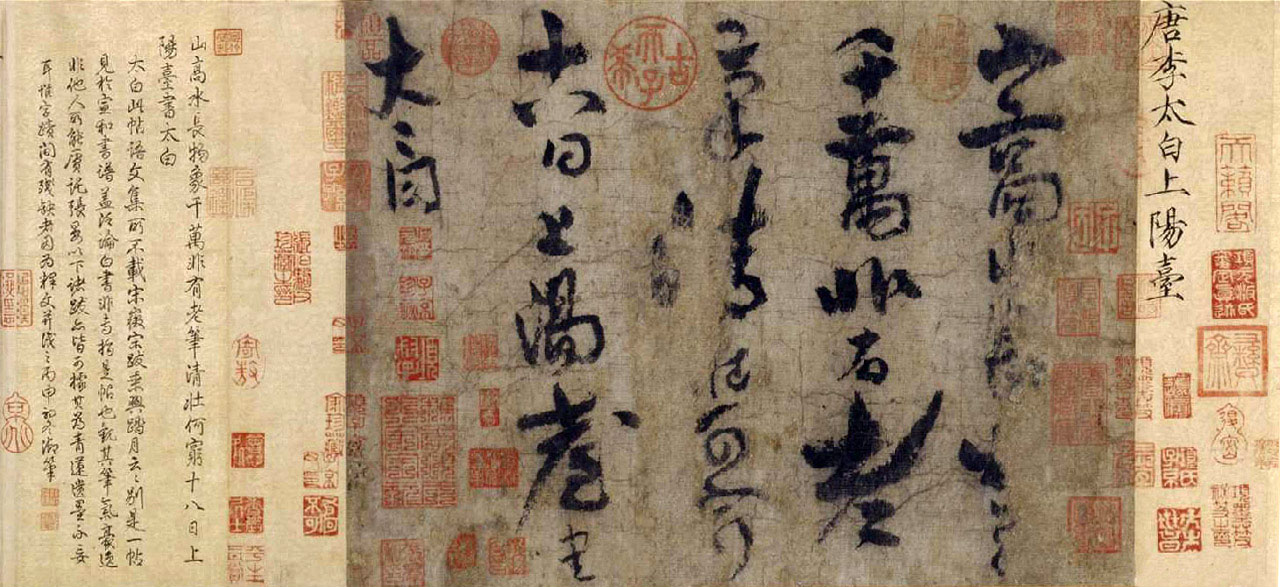
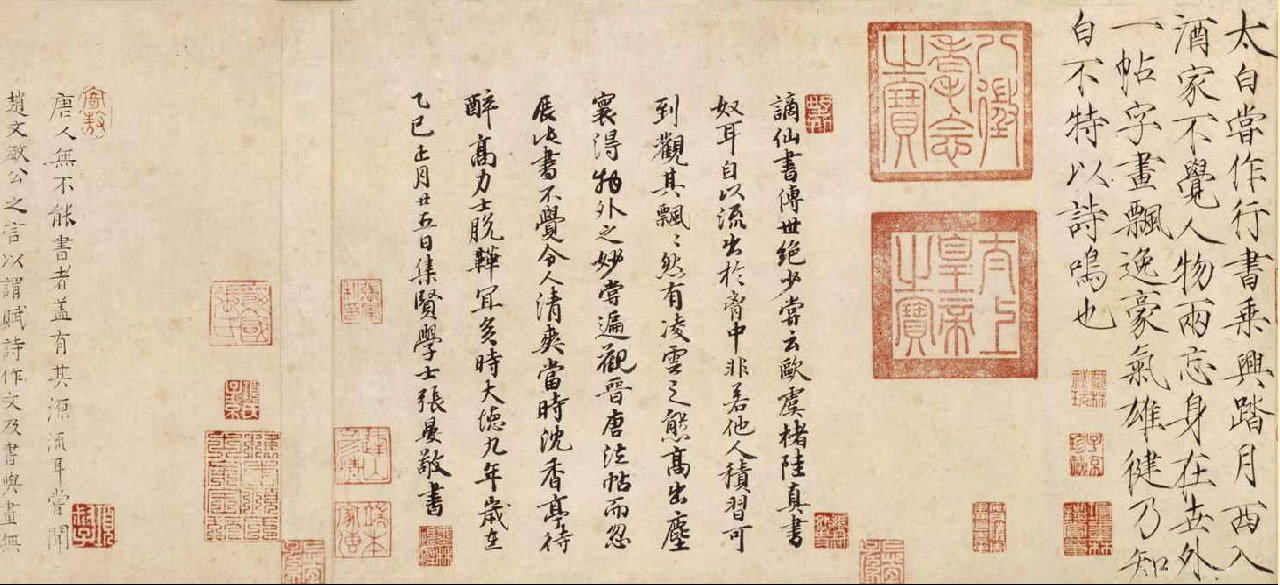 Very few of Li Bai's writings have been handed down from generation to generation, and only this one has been seen so far. Therefore, "Tie to the Upper Balcony" is extremely precious and can be called a "national treasure".
Very few of Li Bai's writings have been handed down from generation to generation, and only this one has been seen so far. Therefore, "Tie to the Upper Balcony" is extremely precious and can be called a "national treasure".
"Tie on the Balcony" is a four-character cursive poem composed by Li Bai. It is also Li Bai's only authentic calligraphy handed down from generation to generation. It begins with the four characters "Qinglian Yihan" in regular script written by Emperor Gaozong of the Qing Dynasty, and is inscribed in gold by Zhao Ji, Emperor Huizong of the Song Dynasty, on the upper right side of the text: "Li Taibai of the Tang Dynasty went to the balcony". The later paper contains inscriptions, postscripts and inscriptions by Zhao Ji, Emperor Huizong of the Song Dynasty, Zhang Yan, Du Ben, Ouyang Xuan, Wang Yuqing, Wei Su, Zou Lu of the Yuan Dynasty, and Emperor Qianlong of the Qing Dynasty.
The seals on the front and back of the volume and across the water include "Zigu" and "Yizhai" by Zhao Mengjian of the Song Dynasty, "Qiuhe Book" by Jia Sidao, "Zhang Yan's Private Seal" and "Ouyang Xuan Seal" of the Yuan Dynasty, Xiang Yuanbian of the Ming Dynasty, Qingbiao and Anqi of the Liang Dynasty of the Qing Dynasty. , the Imperial Household of the Qing Dynasty, and the collection seals of Zhang Boju and others in modern times.
Li Bai's four-character poem "Posting on the Balcony" written by Li Bai: "The mountains are high and the water is long, and there are thousands of objects. Unless you have an old pen, you can be young and strong. On the 18th, I went up to the balcony to write, Taibai." Among them, "The water is long, the objects are like "The four characters have fallen off, are mottled, blurred, and cannot be recognized. The current interpretation is based on the postscript written by Emperor Qianlong of the Qing Dynasty in the 41st year of his reign (1776). The writing in "Up to the Balcony Post" is free and easy, fast and smooth, showing elegance in the vitality and various expressions. The structure is also uneven and full of ups and downs, looking forward to the sentimental and endlessly interesting.
"Tie to the Balcony" was written by Li Bai, Du Fu and Gao Shi, who climbed Wangwu Mountain together in March of the third year of Tianbao (AD 744). Li Bai wrote this post in the Yangtang Palace on March 18 of the same year.
The whole story of "Up to the Balcony Post" gives people the visual effect of a dragon that sees its beginning but not its end. There are only twenty-five characters in the whole poem, which shows his heroic spirit and the sweet and smooth charm of his pen and ink. Li Bai embodies his demeanor, which is bold but not frivolous, calm but not dull. This is Li Bai of the Dharma Book.

